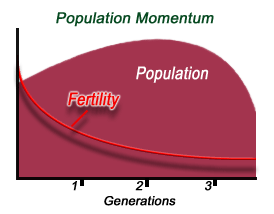Fertility and Population Momentum
US Population
China and India are the world's two most populous countries. The United States, with a population of over 315 million is the third most populated country. (See the Census Bureau population clock). The US has highest population growth rate of all industrialized countries.1
Fertility - Children per Woman
Fertility is defined as the average number of children per woman over the woman's lifetime. Fertility tends to be higher in less developed countries than in industrialized countries.
Replacement level fertility in the United States is approximately 2.1 children per woman (slightly higher than 2 because of child mortality). Women in the United States voluntarily achieved replacement level fertility in 1972. Yet US population has continued to grow because of two factors: mass immigration and population momentum.
Population Momentum
 Population momentum is the tendency for population to continue to grow even after replacement-level fertility (2.1 children per woman) has been achieved. It is caused by a relatively high concentration of people in their childbearing years - that is, by a population that is age-biased toward youth.
Population momentum is the tendency for population to continue to grow even after replacement-level fertility (2.1 children per woman) has been achieved. It is caused by a relatively high concentration of people in their childbearing years - that is, by a population that is age-biased toward youth.
It takes a period of time equal to the average life expectancy (approximately three generations or 73 years in the U.S.) for a reduction in fertility to be manifested as a change in actual population numbers. The following graph shows how population keeps growing long after fertility is reduced.
U.S. fertility first dropped to slightly below replacement level fertility in 1972. Because of population momentum, however, U.S. population would have continued to increase to 255 million by 2020 - without any additional immigration - and then would have gradually declined.2,3,4
It is therefore crucial that this time delay be considered when targeting future population numbers and that steps to reduce fertility are taken sooner rather than later. Any attempt to achieve U.S. population stabilization must consider the long-term impact of both birth rates as well as immigration.
Precise definitions of terms
Fertility:
(1) The actual reproductive performance of an individual, a couple, a group, or a population. See general fertility rate.
(2) The term fertility is used instead of natality when births are put in relation with the number of women of fertile age. The fertility of a generation can be summarized by completed fertility and mean age at childbirth, whereas the total period fertility rate measures the fertility rate for the year.
General Fertility Rate: The number of live births per 1,000 women ages 15-44 or 15-49 years in a given year.
Total Fertility Rate (TFR):
(1) The average number of children that would be born alive to a woman (or group of women) during her lifetime if she were to pass through her childbearing years conforming to the age-specific fertility rates of a given year. This rate is sometimes stated as the number of children women are having today. See also gross reproduction rate and net reproduction rate.
(2) An estimate of the average number of children that would be born to each woman if the current age-specific birth rates remained constant.
(3) A hypothetical estimate of completed fertility. It indicates how many births a woman would have by the end of her reproductive life, if, for all of her childbearing years, she was to experience the age-specific birth rates for that given year. (From U.S. Census Bureau Fertility of American Women: June 2000).
References
1. Population Reference Bureau World Population Data Sheet, various years.
2. Demographer Leon Bouvier, Tulane University, www.NumbersUSA.com "U.S. Overpopulation Facts".
3. National Audubon Society Population and Habitat Campaign Fact sheet on population momentum.
